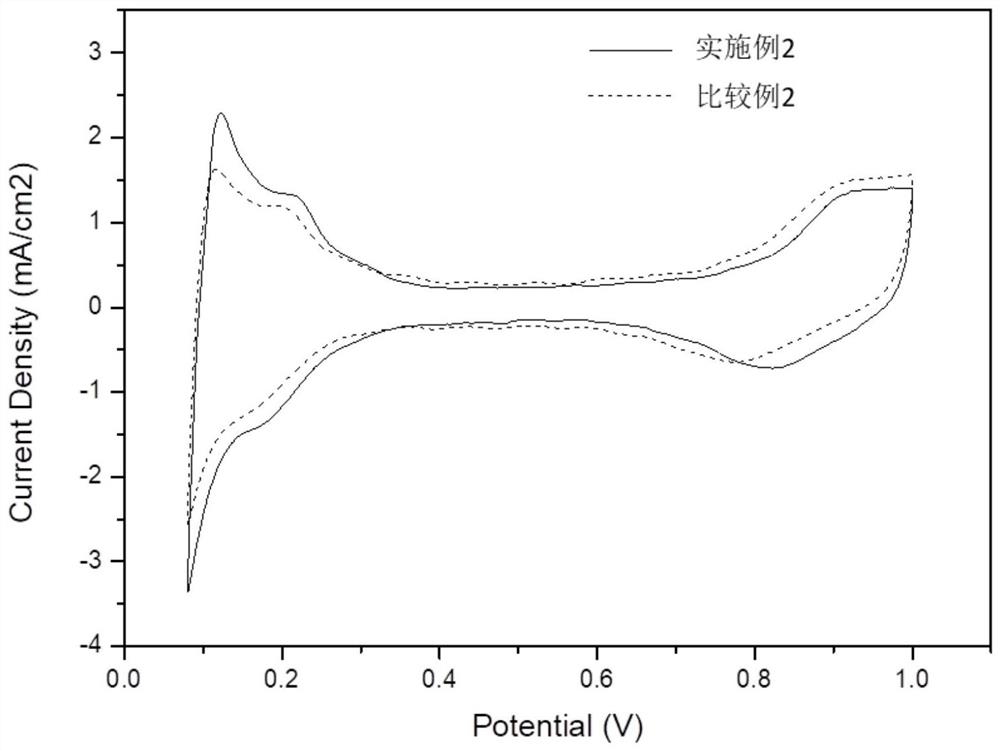Membrane electrode with efficient proton transport network and preparation method of membrane electrode
A transmission network and membrane electrode technology, applied in battery electrodes, circuits, fuel cells, etc., can solve the problems of serious accumulation of ion resin active centers, non-adjustable proton conduction efficiency, and influence on oxygen transmission, etc., to improve proton transfer Mass efficiency, improve oxygen mass transfer efficiency, and prevent excessive accumulation
- Summary
- Abstract
- Description
- Claims
- Application Information
AI Technical Summary
Problems solved by technology
Method used
Image
Examples
Embodiment 1
[0031] A method for preparing a membrane electrode with an ordered proton transport channel, the method comprising the steps of:
[0032] S1, mixing carbon nanofibers with concentrated sulfuric acid and concentrated nitric acid (mass ratio is 1:3:3), reacting at 90°C for 48 hours to obtain sulfonated carbon nanofibers with proton transport ability modified by sulfonic acid groups;
[0033] S2. Add 0.1g of commercial ionic resin solution (20% by wt. perfluorosulfonic acid resin dispersion) and 0.1g of platinum-carbon catalyst (platinum loading 50%) to a mixed solvent of 15ml of isopropanol and water (vol. Ratio 3:1), and add 0.01g of sulfonated carbon nanofibers obtained in step S1, after the mixed slurry was stirred for 24h, the cathode catalyst layer slurry was obtained; wherein, the mass ratio of sulfonated carbon nanofibers to platinum-carbon catalyst is 0.1:1; in the obtained cathode catalyst layer slurry, the mass ratio of the ion resin to the platinum-carbon catalyst is ...
Embodiment 2
[0037] The method of this embodiment is the same as that of Example 1, except that in step S2, the mass ratio of sulfonated carbon nanofibers to the negatively charged platinum-carbon catalyst (the platinum loading of the catalyst is about 50%) is 0.2:1.
Embodiment 3
[0039] The method of this embodiment is the same as that of Example 1, except that in step S2, the mass ratio of sulfonated carbon nanofibers to the negatively charged platinum-carbon catalyst (the platinum loading of the catalyst is about 50%) is 0.4:1.
PUM
 Login to View More
Login to View More Abstract
Description
Claims
Application Information
 Login to View More
Login to View More - R&D
- Intellectual Property
- Life Sciences
- Materials
- Tech Scout
- Unparalleled Data Quality
- Higher Quality Content
- 60% Fewer Hallucinations
Browse by: Latest US Patents, China's latest patents, Technical Efficacy Thesaurus, Application Domain, Technology Topic, Popular Technical Reports.
© 2025 PatSnap. All rights reserved.Legal|Privacy policy|Modern Slavery Act Transparency Statement|Sitemap|About US| Contact US: help@patsnap.com



